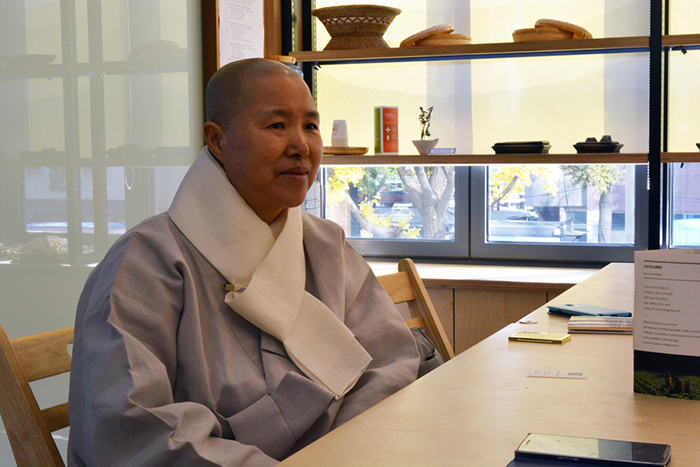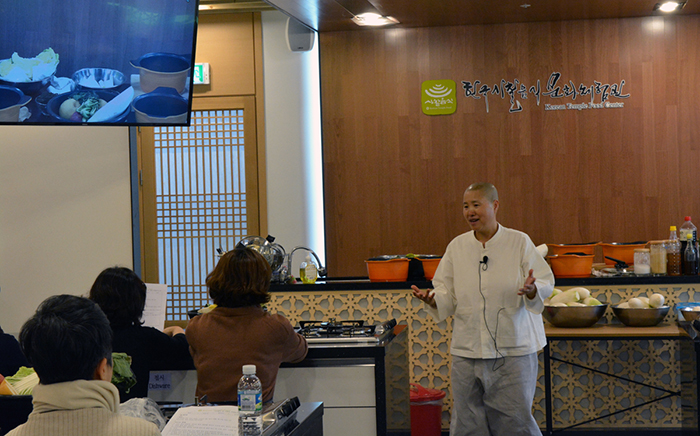View this article in another language
- 한국어
- English
- 日本語
- 中文
- العربية
- Español
- Français
- Deutsch
- Pусский
- Tiếng Việt
- Indonesian

Ven. Sunjae has been introducing temple foods around the world.
By Korea.net Honorary Reporter Vincenzo Acampora Carratura from Italy
Photos = Vincenzo Acampora Carratura
The "Flavors of Korea" event took place in October in Milan, Italy. The festival, organized by the Korean Food Promotion Institute (KFPI) gave a chance to visitors, chefs, journalists and bloggers to learn more about Hansik and taste Korean specialties. Many people attended the lecture by Ven. Sunjae, Buddhist nun and president of KFPI.
We met Ven. Sunjae before her trip to Italy at the Korean temple food center in Seoul.
How did your interest in food start? And when?
I left home and entered monastic life 37 years ago at the Sinheung Temple in Hwaseong, Gyeonggi-do Province. In temples we can only eat temple food. The core spirit of Buddhism that is “mercy” and “wisdom” are also represented in temple food.
The special characteristics of temple food are that no meat is included and that also five vegetables with pungent flavors are avoided (onion, garlic, chive, green onion and leek).
There are many teachings in Buddhism that are relevant to food, but two of the main teachings are:
1. No meat: Respect all animal lives and spirits.
2. There are two kinds of lives in this universe, one is like humans, animals, insects that feel physical pain, the other one is like plants, sea, air, soil that don’t physically feel pain.
No matter what kind of life it is, as a Buddhist monk, we relate to all lives and their pain. For example, if the field is polluted, the plants growing on the field will be polluted as well. People who eat those plants get sick. As you can see we all share so we all share the same pain and damage. And as humans, we are only a small part in the chain of ‘one’.
Another example: chickens that were injected with hormones in order to make them grow fast and produce more meat; when people eat their meat with the chemicals, their bodies are affected.
Thus, we should only take what we really need from nature rather than taking as much as we can or we want. Just like the bees take the nectars from the flowers, they take but they don’t hurt the flowers. The reason why we don't eat the five pungent flavors is because they affect emotions. And in order to have clear spirit you must avoid these.
As a Buddhist nun, I think we must follow these teachings and practice. It is the way to communicate with the whole world. I and the other monks, however, never actively mentioned our dietary routine outside the Buddhist temple, because it is just a very natural and normal thing we do.
Eight years ago, during a trip to Italy, I got to know the Slow Food movement, and I was surprised to see how their principles are very similar to the ones of Korean Buddhism when it comes to food.
After becoming a Buddhist nun, I have introduced some teenage criminals to meditation and helped them change their dietary routine. Through this experience, I saw the changes in their behavior, and people started to be curious and wanting to learn about the power of food. They realized temple food is not exclusively eaten in the temples but this food routine can be brought to people’s lives.
Thus, I started doing more research and writing essays about temple food. While looking after the teenage criminals, it was a hard time for me because I needed to be with them 24 hours a day, to make sure they did not take drugs or commit crimes.
Eventually, irregular working hours and unhealthy food and life routine affected my physical condition, especially my liver function. It took me one year to recover and finish the treatment. During the treatment, once again, I experienced and learned how food affects our physical and mental health. After I recovered, I started giving lectures and teaching about healthy dietary routines on TV. In the beginning, the older monks worried about my public appearances, but as more and more people got to know about temple food and switch to a healthier eating routine, they are glad to see the changes.

Ven. Sunjae teaches at her workshop at a temple food center.
Nowadays people are becoming more aware about healthy eating, how do you think Korean temple food can help people increase their awareness?
I think the main concern is not to decide to eat or not to eat meat, more important concern is where the food ingredient is from and how it is grown. The food ingredient from good nature can help us connect with the land, and help us realize more clearly that all lives are equal. In order to produce good food ingredients, we need to educate people to respect nature and create a more natural environment.
To experience temple food, it doesn’t really have to be in the temples or in Korea, you can also make and eat temple food in Italy, because the concept of temple food is choosing food that suits your body.
The main concept of Buddhist food culture is that we regard food as the medium that connects human beings and nature. Food has life just as human beings do, when we eat good food, it produces positive reactions to our body. Just like making friends, when we get to know people who have positive minds, they affect us positively. On the other hand, people who have negative thoughts or a weak spirit also affect our minds and weaken our energy.
In the last few years you have been travelling a lot in Europe to promote Korean temple food. How have people responded to it?
Many people in Europe seem to be very interested in temple food or in pursuing a more natural and healthier dietary routine. I mainly visit Italy once in a year, so I visited last year, and in the last three years I have also been to Paris and given lectures there. People in these countries seem to take temple food as a new dietary concept and are open to accepting it.
I think most people there did not know much about temple food but they are willing to learn about it. I heard some people had been waiting for my lectures for years, and over 5,000 people joined my lectures. Moreover, I realized that many adults get sick easily after eating unhealthy food for a long time, so the education of respecting nature and healthy dietary routine should be taught to people in their early ages. Some of the projects we produced, an educational musical and a school tour, were made to educate young students in healthy eating.
But to learn about temple food, I think it is necessary to know and gain more “wisdom” and “mercy,” so that we get to know how to treat nature and all living beings in a proper way.

Ven. Sunjae and Korea.net Honorary Reporter pose for a photo.
wisdom117@korea.kr
* This article is written by a Korea.net Honorary Reporter. Our group of Honorary Reporters are from all around the world, and they share with Korea.net their love and passion for all things Korean.